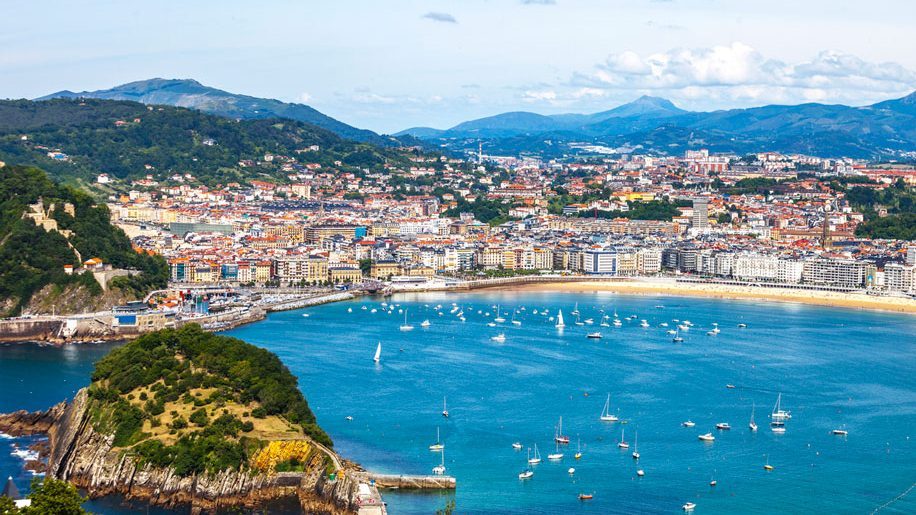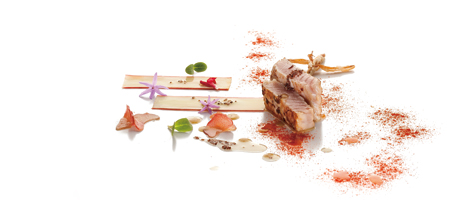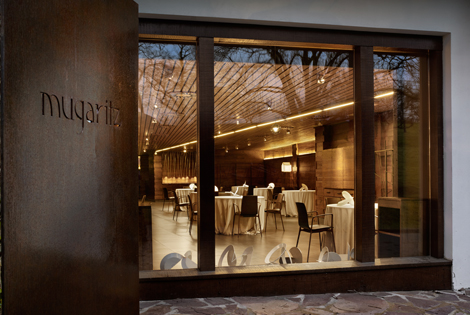
With 16 Michelin stars for a population of 200,000 people, San Sebastian has one of the highest Michelin stars per capita, beaten only by Kyoto.
Of the seven restaurants with three Michelin stars in Spain, you will find three of them in San Sebastian: Arzak, Akelarre, and Martin Berasategui. There are also a number of two- and one-starred establishments, lauded by listings such as the World’s 50 Best restaurants.
While in San Sebastian, it is imperative to experience Michelin Star dining. I zero in on two of the local favourites: Arzak (three stars) and Mugaritz (two stars).
Arzak
Spanning four generations of chefs and currently helmed by Juan Mari and his daughter Elena (World’s Best Female Chef 2012), legendary dining institution Arzak is still housed in the same building as when it first opened in 1897. The kitchens are narrowly split between levels, with several dining rooms, and a vast wine cellar. I meet Juan Mari at the lab, amid thousands of rows of neatly stacked plastic containers filled with flavour profile inspirations from all over the world.
Despite the restaurant’s long history, don’t expect traditional recipes at Arzak: what has been passed on through generations is culinary innovation. What they create must be inventive, but ultimately it must pass 73-year-old Juan Mari’s discriminating palate.

I sit at the dining table on the first floor, where diners are excited to be savouring the meal of a lifetime. Next to our table, four Americans have taken a culinary journey to San Sebastian. The meal at Arzak is their last before heading to Bordeaux for more wining and dining. The meal begins with a parade of food: bright red moringa and prawn gyoza, banana and squid, “txistorra” (sausage) with beer and mango, each with clever presentation: in a spiral cord, in a wooden sculpture, a clear bottle, and a crushed beer can. The seasonal vegetables arrive with an iPad below, showing a video of fiery flames.
Baffled by the food set before me for the next course, the knowledgeable waitress enlightens me on the crispy manioc, a South American root crop stuffed with a preparation of onion, green tea, and foie gras. I admire the gorgeous polka dot plate bearing a “red space egg” dish set before me; the egg is cooked at 65 degrees, served with red peppers, cereal ferments, and crispy pig trotters: gorgeous but also comforting and delicious.
Arzak excels at keeping diners engaged with their food. They serve line-caught squid sizzling in a hot pan on a bed of pandanus leaf, quickly enveloping the entire dining room with the aroma of the sea. I am served a basket of black lemons for dessert, filled with citrus lemon cream. Between tables, diners deliver a running commentary on their food, and the American diners tell me it’s the best meal they’ve had in San Sebastian. Juan Mari bids his diners goodbye before they leave, even gamely posing for photos. He jokes and teases, making you feel as if you’ve dined in a friend’s home instead of a Michelin-starred establishment.
Mugartiz
Some 15 minutes away from downtown San Sebastian in Errenteria lies Mugaritz, a two Michelin-starred restaurant with Andoni Luis Aduriz at the helm. It has consistently ranked number six in the World’s 50 Best Restaurants list for the past decade.

Dining at Mugaritz may be likened to a 25-course culinary performance. The movements of the chefs are creatively choreographed and every dish is an artwork, often not recognisable as food. The dining table is intentionally bare, adorned only with a rolling ceramic sculpture. It is a reminder to keep moving: when a fire struck Mugaritz a few years ago, it was back in business just four months later.
The first morsel I encounter from the kitchen is a fluffy green ball that resembles a grassy science project. This is teff, an Egyptian grain that has sprouted and is then filled with hazelnut cream by the kitchen. It is served without utensils, encouraging diners to use their hands to eat. I pick up the edible green ball, fascinated first by the sensation on my fingers, then in my mouth. There’s also a savoury cheesecake with mushrooms unlike any I’ve tried, but the crunchy Iberian pork tail with wild sorrel is my favourite dish. Expect to encounter unusual flavour pairings like squash and coffee treacle, or clams and dahlias, and conceptual dishes such as “beef candy”: a gelée of beef shaped like a cow’s face.
The meal ends with a towering wooden sculpture called “Seven Deadly Sins,” symbolising pride, envy, wrath, gluttony, greed, lust, and sloth in containers filled with chocolate. Despite being stuffed, you are still disappointed when there is no chocolate in the container labelled greed: this is the wit Mugaritz serves with its haute cuisine.
ON THE PINTXOS TRAIL
You can expect to shell out about $200 (US$213) for a tasting menu at one of San Sebastian’s Michelin-starred restaurants. But you can also sample excellent food in this seaside city for as little as $2.50 (US$3). Over and over, I was told, “You have to try the pintxo in San Sebastian – it’s not like the tapas anywhere else in Spain.”
They are called pintxos because many of the dishes sit atop a slice of baguette and are held together by a pincho (spike) – usually a skewer or toothpick.
Most bars serve plates of pintxos – popular toppings are anchovies, tortilla de patatas (Spanish omelette) and stuffed peppers – throughout the day, but from around 7pm, the mood starts to become more festive in the parte vieja (old town). Much like a street party, people flock to the bars to have a drink and one or two pintxos, then move to the next bar.
To the uninitiated, it becomes a dizzying task choosing from the city’s hundreds of pintxos bars. But with help from top chefs in San Sebastian, I know which pintxos bars to hit: I start at Calle 31 de Agosto, a bar-filled street in the shadow of Basilica of Santa Maria. A Fuego Negro stands out for its grand selection of modern pinxtos, cooked to order: try the txangurro ice cream, a sublime combination of crab and ice cream over avocado.
My favourite street would have to be Calle Fermin Calbeton, where I found Bar Borda Berri and its delicious callos de bacalao (cod tripe). Bar Goiz-Arg is an absolute must for their gambas a la plancha. The prawns are simply cooked in a hot plate, but trust me, I’ve never had prawns cooked as perfectly as this.
It is customary to wash down your pintxos with Txakoli, a slightly sparkling young fruity white wine produced in the Basque, Cantabria and northern Burgos regions. The bartenders pour Txakoli at great height to aerate the wine, which has the added bonus of impressing customers. Just across the river from old town is Barrio de Gros, an emerging pinxtos neighbourhood that offers a pinxto and drink for €2 (US$2) on Thursdays.
Cultural highlights
GASTRONOMIKA
Every October, the number of Michelin-starred chefs in the city surges to even greater levels at Gastronomika, a culinary congress established 17 years ago following the emergence of New Basque cuisine. Inspired by France’s nouvelle cuisine, this gastronomic movement took tapas to a whole new level, with San Sebastian chefs Juan Mari Arzak and Pedro Subijana at its helm.
Unlike other culinary congresses, there is a distinct sense of brotherhood among the chefs at Gastronomika, where Joan Roca of El Cellar de Can Roca (World’s Best Restaurant 2015), Albert Adria, Andoni Luis Aduriz, and Elena Arzak converge to meet up and share ideas. It is a safe space where they can openly present their latest culinary projects, and discuss what worked and what didn’t. It does not matter if they are Basque or Catalan: for all of them, attending Gastronomika is a homecoming. “I think all chefs were born professionally in this congress,” says Roca.
EUROPEAN CAPITAL OF CULTURE
San Sebastian has been selected as the European Capital of Culture for 2016 – and naturally, special pintxos have been dreamed up to mark this occasion. Chef Pedro Subijana of three-Michelin starred Akelarre has created the Melina Mercouri pintxo, anchovies between pieces of bread drizzled with olive oil. In addition, 12 chefs from different European countries will be hosted in San Sebastian restaurants to showcase recipes from their region using local ingredients and techniques.








